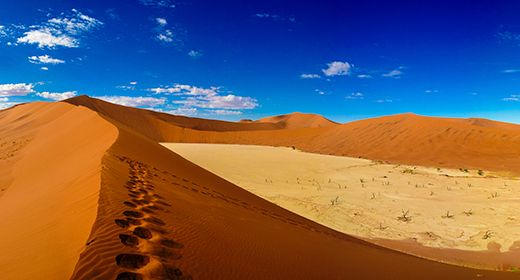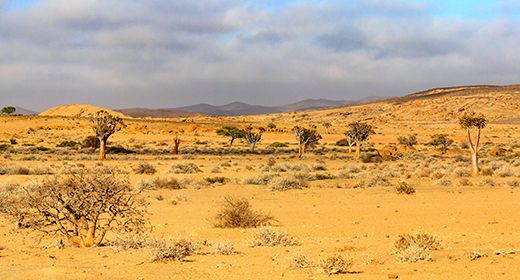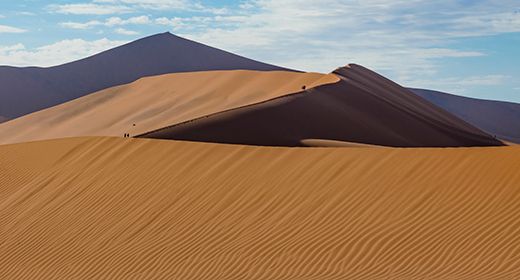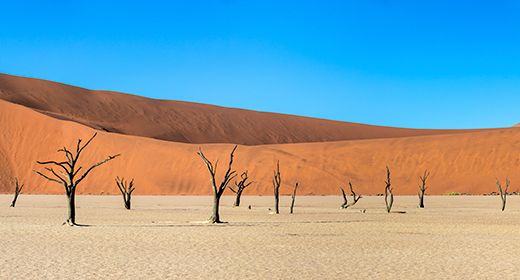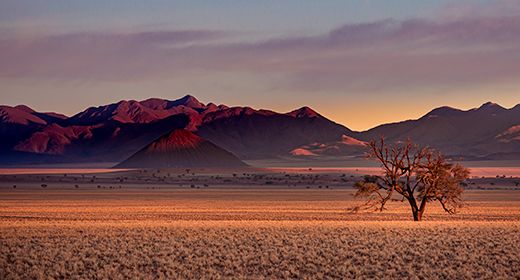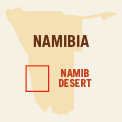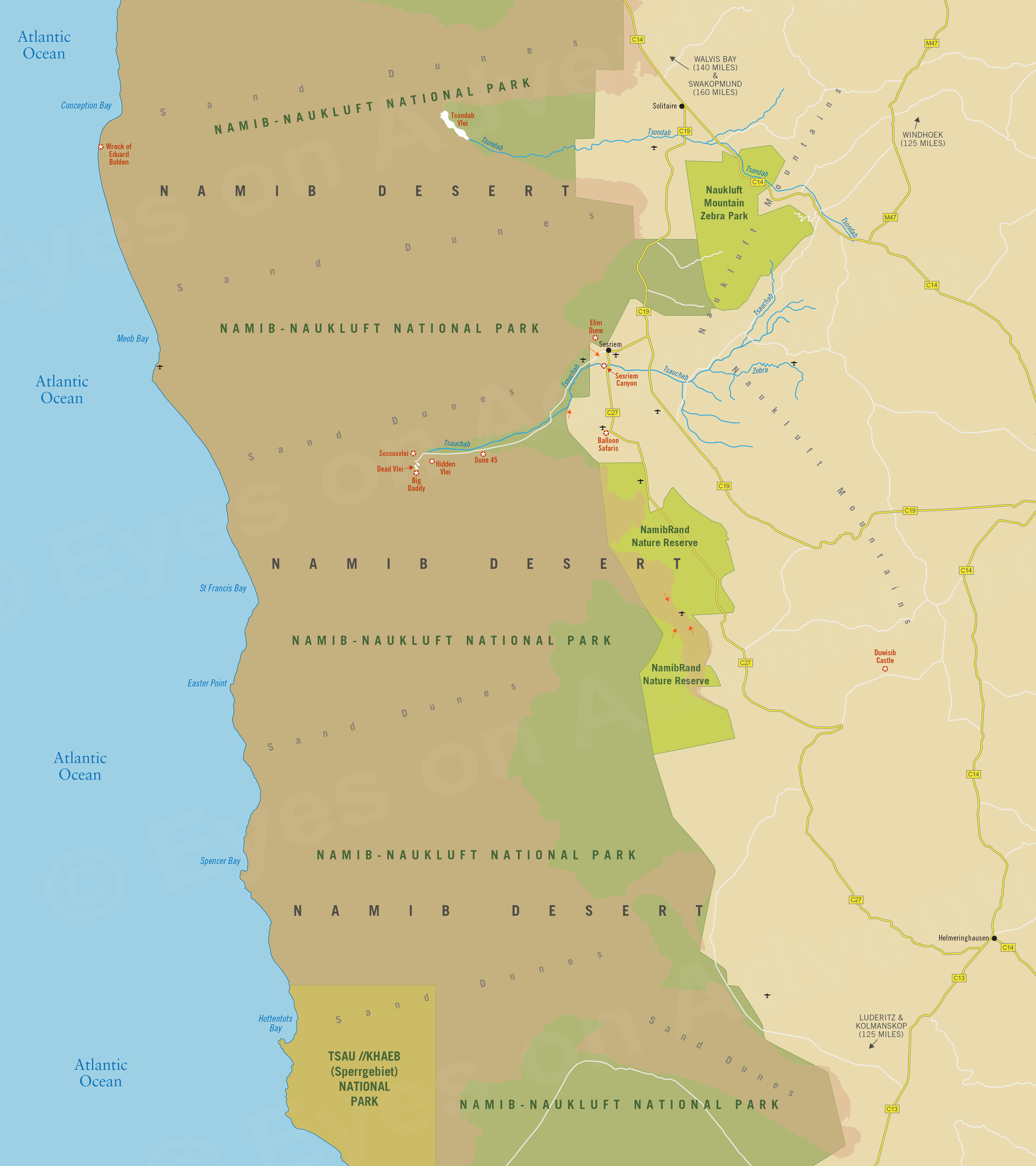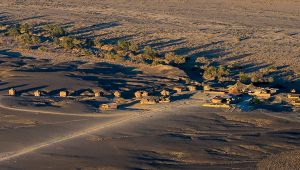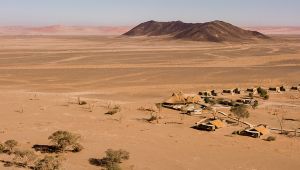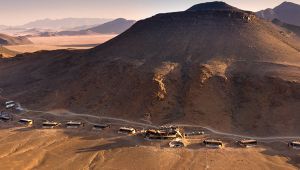Namib Desert & Sossusvlei
(incl. NamibRand Nature Reserve, Namib-Naukluft National Park)
Region Links: Caprivi / Zambezi, Damaraland & Waterberg, Etosha, Namib Desert & Sossusvlei, Skeleton Coast, Kaokoland & Kunene, Swakopmund, Windhoek
Highlights
- Visit the Namib, the world's oldest desert
- Climb to the top of "Big Daddy" dune, which stands over 1,100 feet high
- Explore the surreal scenery at Dead Vlei
- Go on safari in the NamibRand Reserve to view desert-adapted wildlife
- Glide peacefully over the red dunes on a hot-air balloon excursion
EOA Recommends: Kulala Desert Lodge, Sossusvlei Desert Lodge, Wolwedans Boulders Camp, Wolwedans Dune Camp
The Namib Desert is the world's oldest desert, dating back 55 million years. It is also one of the most beautiful places on Earth and no visit to Namibia would be complete without visiting this amazing destination.
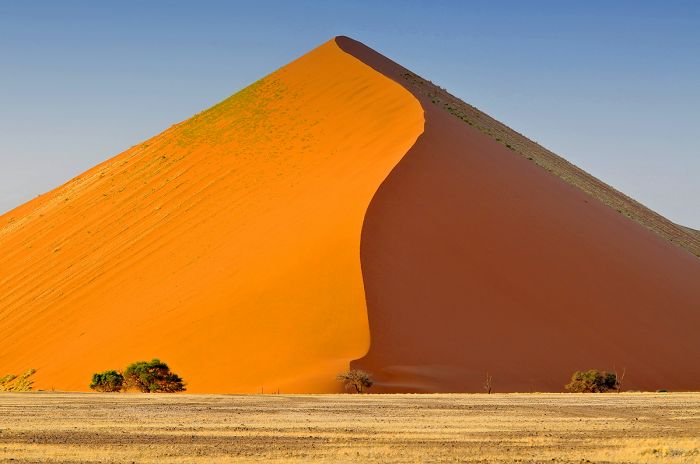
The spectacular Dune 45 in the Sossusvlei area.
Protecting the desert is the Namib-Naukluft National Park, one of Africa's largest protected areas, covering 19 200 miles (50 000 sq kms), an area larger than the country of Switzerland. Much of the southern portion of the park is inaccessible, but the central part of the park is open for tourism.
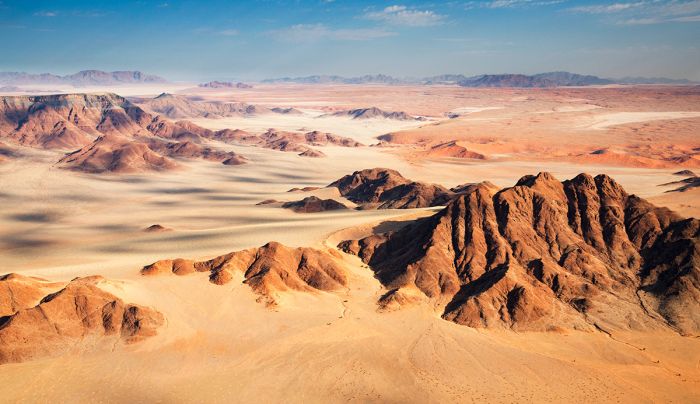
The Namib Desert is protected within the Namib-Naukluft National Park.
The region around the small town of Sesriem is known as Sossusvlei and it is a photographer's dream. Here there are gigantic red dunes, some towering more than 1 000 feet (300+ meters) above the desert plains below. The colors on the dunes are always shifting as time passes throughout the day, from gold to orange/red to ochre and purple. It seems that no matter where you look, it's a jaw-dropping postcard image.
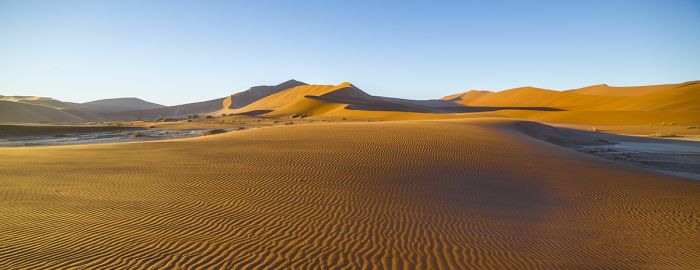
Early morning view of the pristine dunes at Sossusvlei.
Hiking to the top of the biggest dunes, like Big Daddy or Dune 45, and admiring the 360-degree vistas, is one of the highlights at Sossusvlei. The surreal Dead Vlei, with its parched and cracked white-clay surface and the skeletal, long-dead camelthorn trees set against a backdrop of red sand, is like no place you'll ever see.

Dead Vlei with red dunes in the Sossusvlei area.
Bordering the national park and not far from Sossusvlei is the privately-owned NamibRand Nature Reserve, which offers excellent accommodation, more spectacular scenery, and good chances to see some of the desert-adapted wildlife that live here.
Any trip to Namibia should definitely include some time in the Sossusvlei region and we recommend a minimum of three days to truly enjoy this remote and beautiful desert setting.
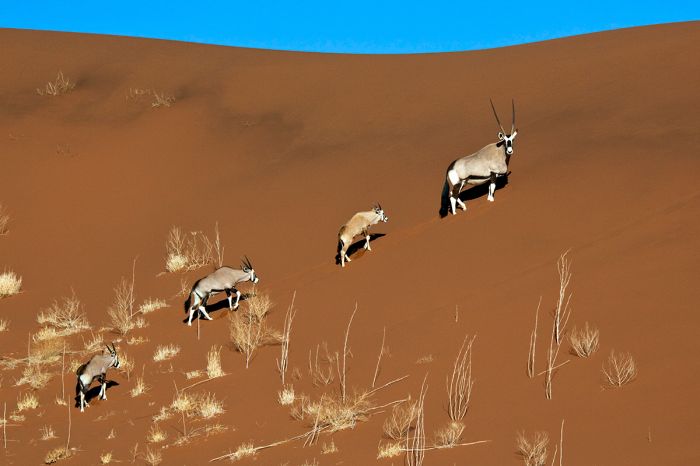
Some oryx climbing a dune in the Namib.
Read More...
Balloon Safaris, Big Daddy, Dead Vlei, Dune 45, Duwisib Castle, Elim Dune, Namib-Naukluft National Park, Namib Desert, NamibRand Nature Reserve, Naukluft Mountain Zebra Park, Sesriem, Solitaire, Sossusvlei
The Namib Desert
The greater Namib Desert stretches along the Atlantic coast for more than 1 200 miles (2 000 kms) from southern Angola, through Namibia, and into the northern parts of South Africa. With annual rainfall in most of its area averaging less than 1 inch per year, it is the only true desert in Southern Africa.

Namib Desert landscape, with red sand dunes.
The Namib has experienced an arid or semi-arid climate for roughly 55-80 million years, making it quite likely the oldest desert on Earth (the Atacama Desert is South America is roughly the same age).
The "sand sea" (also called an "erg") of wind-swept dunes (with little to no vegetative cover) along Namibia's coast spans 425 miles (680 kms) from Swakopmund in the north to Luderitz in the south and inland for 90 miles (150 kms) in some places, including the Sossusvlei region. Areas to the north and south of the dunes, including Damaraland, are more defined by scattered mountains, rocky outcrops, inselbergs (from the German for 'island-mountain'), and gravel-strewn plains.
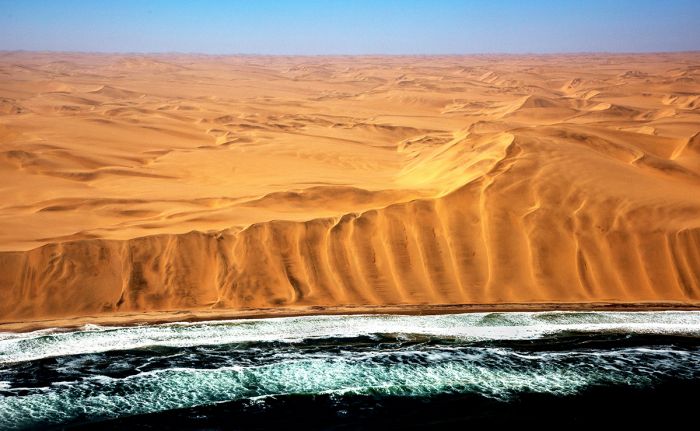
The enormous "sand sea" is made of sand blown inland from the Atlantic Ocean.
The Atlantic Ocean water along the coast of the Namib Desert is influenced by the frigid Benguela Current, flowing north from the Antarctic. When this cold water mixes with the hot, dry air of the desert, it creates a thick fog for up to 180 days per year. This has led to hundreds of shipwrecks, many of which are still visible along the coast. While disastrous for the mariners on these ships, the coastal fog is a vital source of moisture for desert plants and animals living in the Namib.
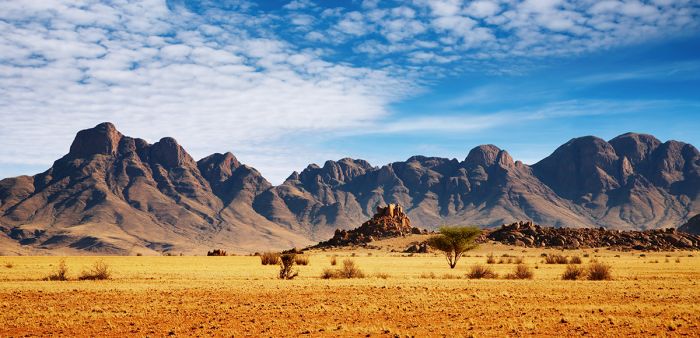
Mountains in the Namib Desert.
Other than some small settlements and the indigenous semi-nomadic, pastoral people (the Himba and Herero), the Namib is almost totally uninhabited by humans. Few animals can survive in this harsh environment, and in the dune-dominated regions, it is mostly arthropods and other small animals that survive on little water.
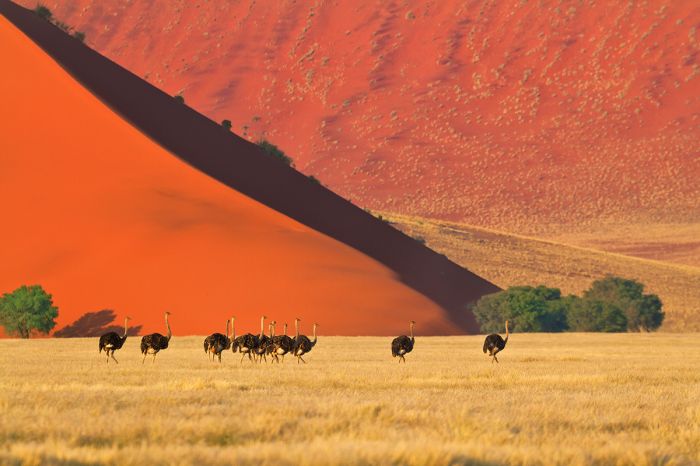
Ostriches in the Sossusvlei area.
Large animals do survive in the Namib outside of the dune areas, including numerous antelopes, such as oryx and springbok. Other species here include desert-adapted elephant, lion, Hartmann's mountain zebra, black-backed jackal, brown hyena, red hartebeest, ostrich, meerkats, and others.
A large portion of the Namib Desert is now protected in national parks or nature reserves, including Skeleton Coast National Park, Dorob National Park, and Namib-Naukluft National Park.

Desert landscape in the Namib-Naukluft National Park, Namibia.
Namib-Naukluft National Park
The Namib-Naukluft National Park protects a large portion of the Namib Desert. It is the largest national park in Africa and one of the largest in the world, covering 19 215 sq miles (49 768 sq kms). In 1907 the German Colonial Administration proclaimed a small reserve near Swakopmund called "Game Reserve No. 3" (the other two being Etosha and Omuramba). In 1941, the area around Sandwich Harbor was added by South Africa (who administered South West Africa after WWII).
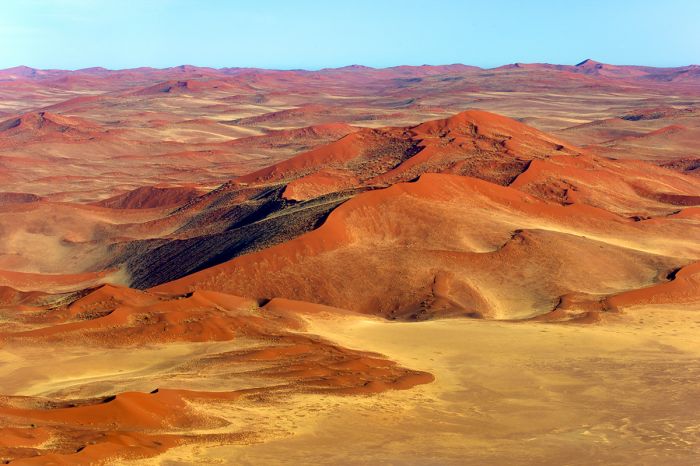
View over the Namib-Naukluft National Park.
In 1966, the reserve was renamed as Namib Desert Park and expanded further south to the Kusieb River valley north of Solitaire. In 1979, a vast tract of land previously set aside for diamond mining by De Beers (known as Sperrgebiet or Diamond Area No. 2), was incorporated into the park. This massive new area includes Sossusvlei and Sesriem and the park was joined to the existing Naukluft Park to form the Namib-Naukluft National Park.
In 1986, additional diamond mining land was added to the reserve, stretching its southern border all the way to the road leading to Luderitz and increasing its area to its present size, which is larger than the country of Switzerland.
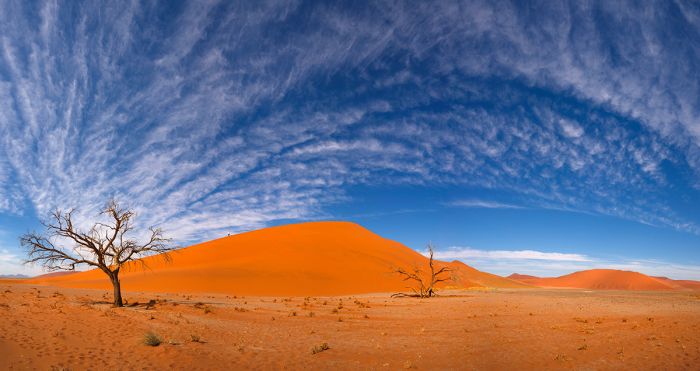
A lone hiker walking up a dune ridge in Sossusvlei.
Sossusvlei
Technically, Sossusvlei (sometimes written as Sossus Vlei) is one of many small, clay-encrusted pans surrounded by the towering, red dunes that typify the regions. The name "Sossusvlei" is also used to refer to the entire region surrounding the Tsauchab River, the tiny town of Sesriem, all the dunes, including "Big Daddy" and "Dune 54", and all the pans, including "Dead Vlei".
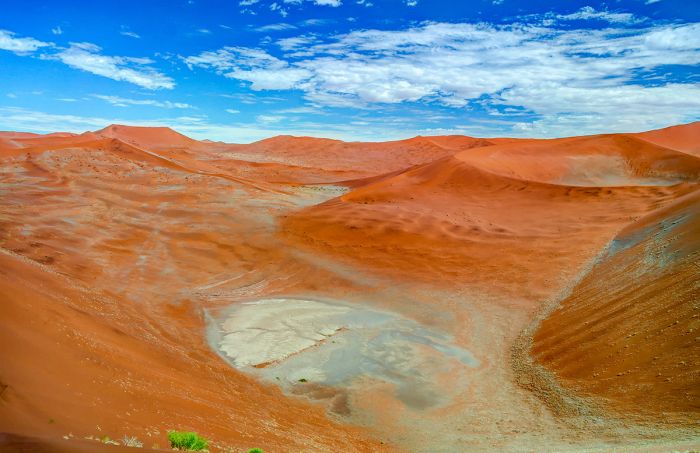
Spectacular red dunes surround a pan or "vlei" in the Sossusvlei area.
The Sossusvlei area is part of a 12 000-square-mile (32 000-sq-km) "sand sea" that characterizes this region. It is estimated that the sand in this region originated between three and five million years ago in the Kalahari Desert of northern South Africa. The sand was washed down the Orange River and into the Atlantic Ocean, where it was then carried north in the coastal water via the Benguela Current to be dumped onto Namibia's coast. Wind then swept the sand inland, forming the huge area of dunes.
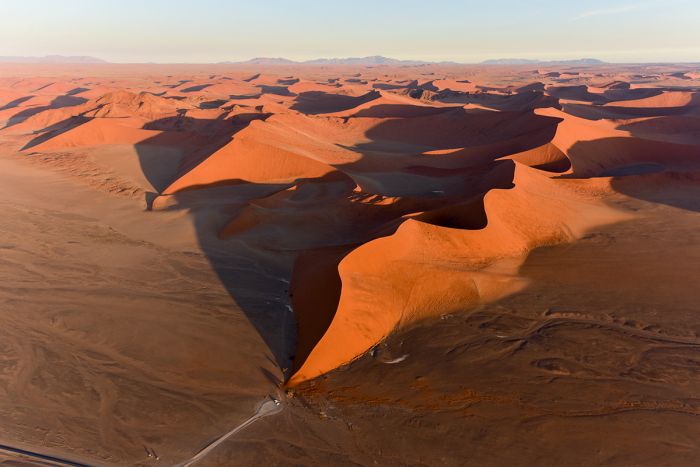
Aerial view over sand dunes in Sossusvlei ("Dune 45" in the foreground).
Many of the dunes are orange or reddish in coloration, owing to the high iron content and resulting oxidation. The longer the oxidation has been taking place, the more red the color of the sand, so the oldest dunes are a deeper red, while the younger dunes appear more yellow. The vivid colors of the dunes are also affected by the angle of sunlight and throughout the day, the dune colors will shift between myriad shades of lilac, purple, rose, ochre, apricot, and deep red.
The dunes of Sossusvlei are simply spectacular to behold. Some tower over 1 000 feet (300+ meters) above the plain. The well-known Big Daddy dune at Deadvlei is about 1 066 ft (325 meters) high. Many of the oldest and tallest dunes around Sossusvlei are stabilized by some vegetation, which obtains moisture from the common morning fog that blows in from the Atlantic Ocean coast.
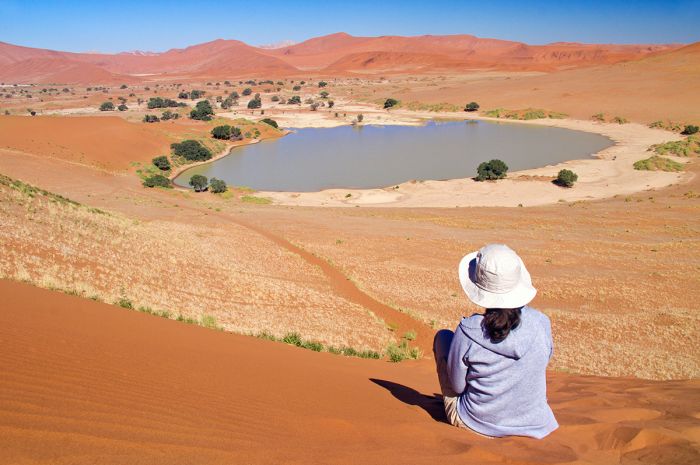
A very rare sight, water fills a normally dry pan in Sossusvlei.
Several ephemeral rivers, which flow only on rare ocassions from the Naukluft Mountains lying inland, bring water into the dune field. The rivers terminate as endorheic pans (drainage basins with no outflows). These pans are almost always dry, with a hard, sand-and-clay-encrusted surface that is whitish in color due to the salts left behind from evaporation.
The Sossusvlei pan still receives water from the Tsauchab River on occasion, but sometimes several years may pass between floodings, as the Tsauchab is dry most of the time and even when it flows, it rarely reaches all the way to the pans.
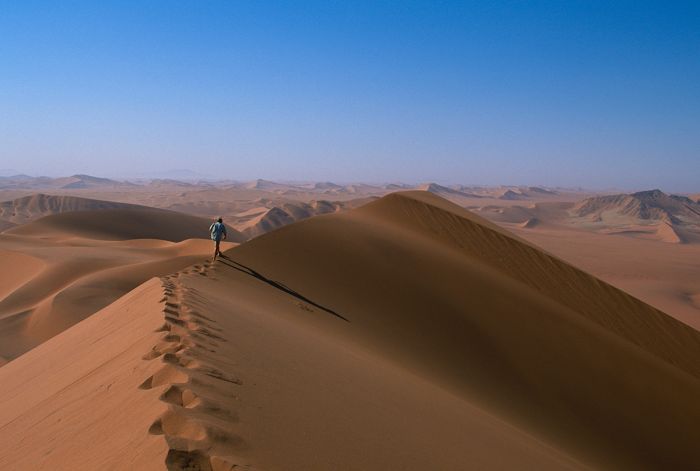
Walking along the ridge atop Big Daddy in Sossusvlei (Copyright © James Weis).
Deadvlei is another pan situated at the end of the Tsauchab river. Over time during a period of healthy rains in the Naukluft Mountains, camelthorn trees (Acacia erioloba) grew at Deadvlei, but at some point, the river course was slightly altered and as the pan grew more and more dry, the trees all died. Today the surreal scene at Deadvlei is one of the most impressive sights in the region, with the 'skeletons' of the long-dead trees casting shadows on the baked, white surface of the pan and surrounded by the spectacular red colors of the massive dunes all around.
Sossusvlei is a special place. Devote at least three nights of your itinerary to the region and plan to take lots of photos. Arrive at the park gates early (they open an hour before sunrise), so you can beat any crowds, see the dunes with no footprints, and experience the early morning colors.
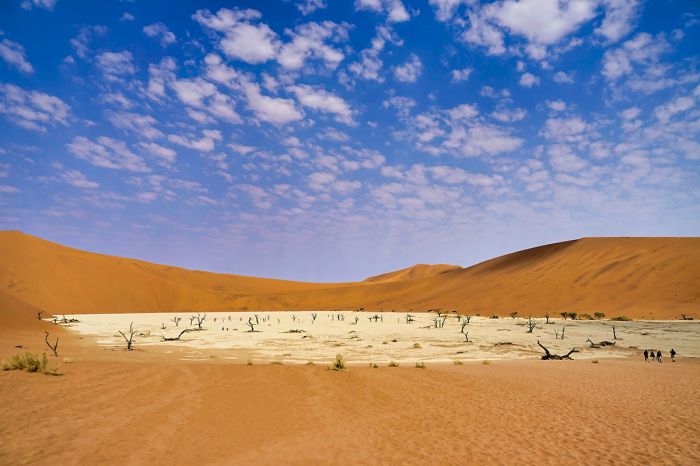
Dead Vlei is one of Sossusvlei's most beautiful places.
Notable Dunes
Some of the biggest and most impressive dunes in the area have been given names and are popular for their size, shape, beauty and for climbing by those who want to take that challenge. Be warned that climbing any of the big dunes around Sossusvlei means a long and exhausting trudge through fine, loose, ankle- or sometimes knee-deep sand. Climbing in the early morning is best, as once the sun is up, you can add heat to the equation!
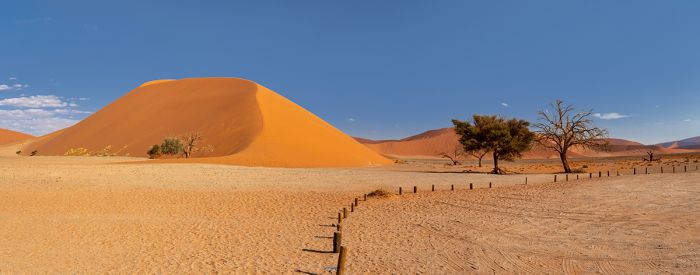
View of Dune 45 from the visitor parking area.
Big Daddy: Located at the back end of Dead Vlei, "Big Daddy" is surely the best-known and most popular dune to climb. Views from the top are superb and gives a bird's-eye view over the surreal, white pan and skeletal camelthorn trees below. Big Daddy stands 1 181 feet (360 meters) tall and hiking to the top can take up to one hour.
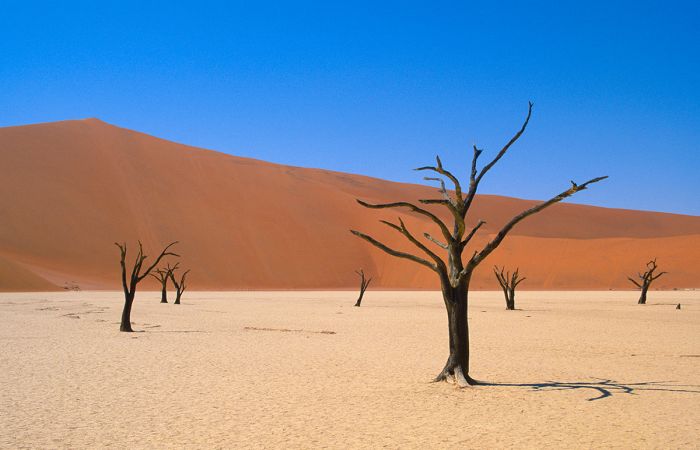
Long-dead camelthorn trees in Dead Vlei and the "Big Daddy" dune (Copyright © James Weis).
Dune 45: So named for its location, 45 kms along the road from Sesriem, "Dune 45" is perhaps the most photographed dune in the region. Its spectacular shape, massive size, and setting with grassland and some bushes at its base, make it a standout even in all the surrounding beauty. The colors and shading on Dune 45 seem to shift by the minute, as the angle of sunlight shifts throughout the day. Dune 45 stands 560 feet (170 meters) high and the climb to the top is much easier than Big Daddy, due to its more moderate slope.
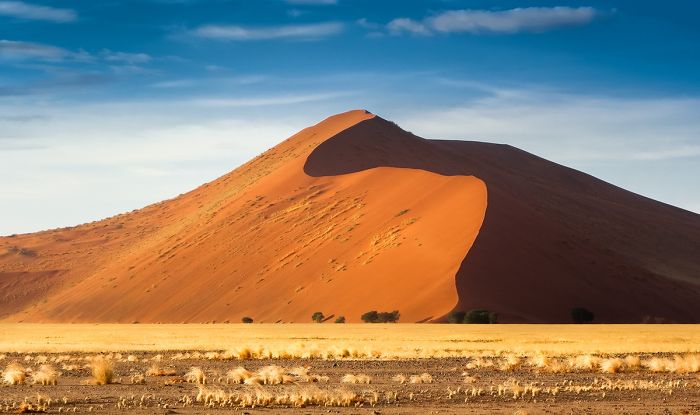
The spectacular Dune 45 in Sossusvlei.
Elim Dune: The majestic and rather secluded "Elim Dune" sits at the eastern edge of the sand dune sea and is the closest (3mi/5km) dune to Sesriem. Its summit is a very popular place for watching the sunset and provides stunning views of the surrounding desert, mountains, and plains. The name comes from a nearby farm that existed prior to the establishment of the national park. Elim Dune is roughly 325 feet (100 meters) tall and the climb takes about one hour.
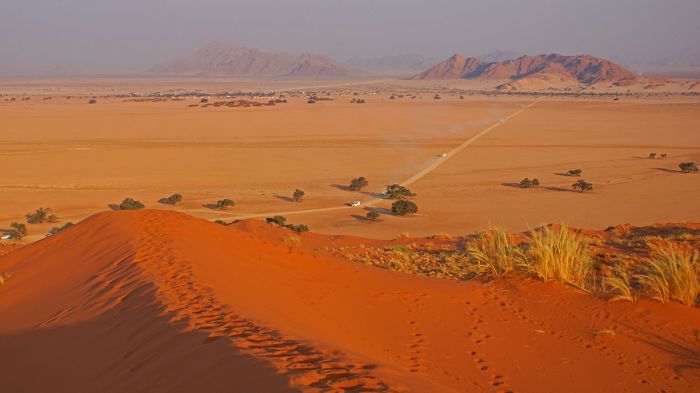
View from atop Elim Dune showing the road to Sesriem.
NamibRand Nature Reserve
Located just south of Sesriem and bordering the Namib-Naukluft National Park, the NamibRand Nature Reserve is comprised of a number of former sheep farms that have converted to wildlife and nature conservation. The reserve covers 810 square miles (2 100 sq kms) of desert grassland, rocky outcrops, bouldered hills, rock-strewn plains, dunes, valleys, and dramatic mountains. It is one of Africa's largest privately-owned reserves.
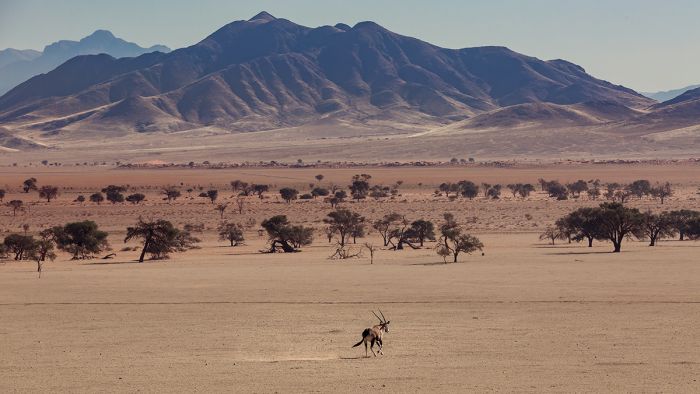
A lone oryx on the plain in the NamibRand Nature Reserve.
The NamibRand is one of the best places in the Sossusvlei region to see wildlife. Species living in the reserve is mostly the same as that in the western side of the Namib-Naukluft, and includes oryx, springbok, Hartmann's mountain zebra, red hartebeest, greater kudu, klipspringer, bat-eared fox, Cape fox, spotted hyena, leopard, chacma baboon, black-backed jackal, and more.
Several safari operators offer accommodation and a wide range of expertly-guided activities in the NamibRand and this is an excellent place from which to base a visit to the area.
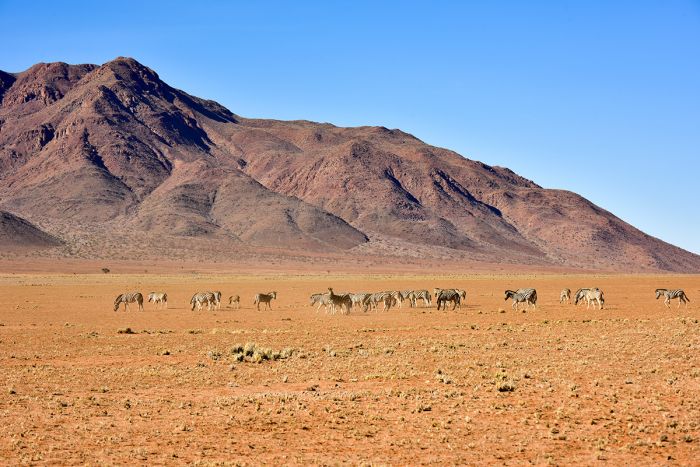
A herd of zebras in the NamibRand Nature Reserve.
Sesriem & Sesriem Canyon
Sesriem is the small gateway town for the Sossusvlei area. The name means "six thongs" and refers to the number of leather hide straps (called reims) that had to be tied together to lower buckets to the bottom of the Tsauchab river gorge in order to fetch water.
The Sesriem Canyon has been carved out by the Tsauchab river over roughly 15 million years and is one of the few places in the region that has water most of the year. The canyon is about 100 feet (30 meters) deep and runs for about 2 miles (3 kms). The canyon is accessed via a stairway cut into the rock that leads to two trails through the interesting rock formations.
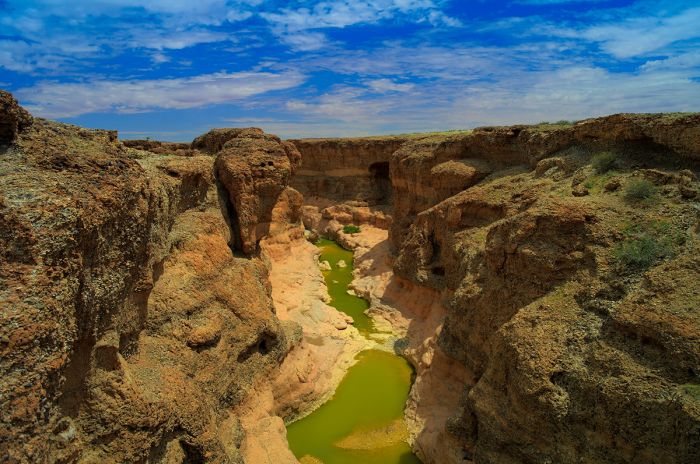
The Tsauchab River in Sesriem Canyon.
Solitaire
The lonely and appropriately-named town of Solitaire is nothing more than a few building in the middle of the desert, about 50 miles north of Sesriem. There are some good lodges in the area that are based around the ephemeral Tsondab river and the Naukluft Mountain Zebra Park.
Balloon Safaris
One of the best ways to view the vast sand dune sea is to take a sunrise excursion on a hot-air balloon. Floating over the area in the early morning light is simply breathtaking and gives a better appreciation for the immensity of this desert. Pickups are usually 30 minutes before sunrise and can be arranged ahead of time as part of your stay at most lodges.
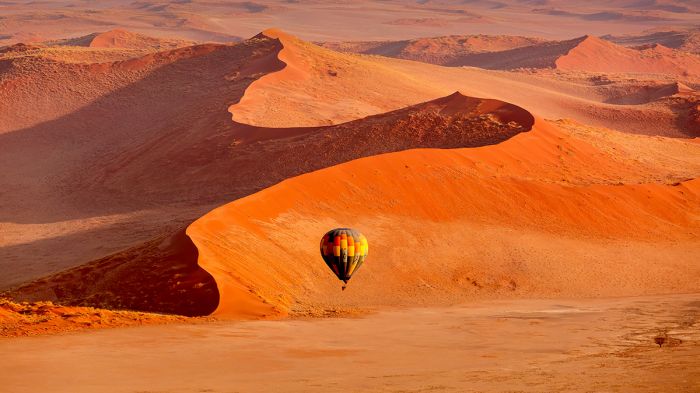
Soaring over the dunes near Sossusvlei on a balloon excursion.
Naukluft Mountain Zebra Park
The Naukluft Mountain Zebra Park is located near the little town of Solitaire and on the eastern border of the Namib-Naukluft National Park. The park is not often visited and the only accommodations inside the park are camping sites. There are several well-marked hiking trails that run along or near the Tsondab River, which runs through the park.
Naukluft Mountain Zebra Park was originally created as a sanctuary for its population of Hartmann's mountain zebras.
Duwisib Castle
Built in 1909 by Baron Captain Hans Heinrich von Wolf, this medieval-looking castle is located in the middle of the desert, far from pretty much everything. Von Wolf and his wife lived in the house until WWI broke out and the Baron was killed at the Battle of the Somme. The castle is now a tourist stop.
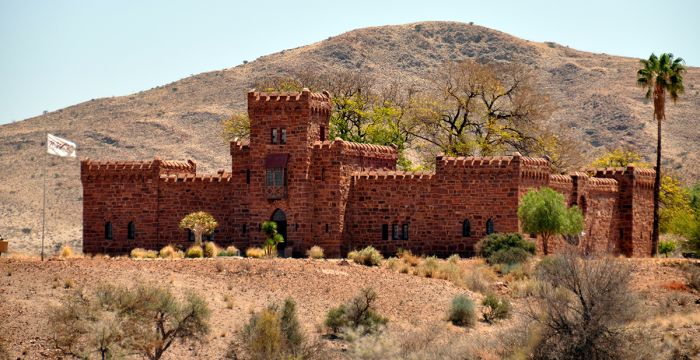
Duwisib Castle, east of the NamibRand Reserve.
Read More...
Balloon Safaris, Big Daddy, Dead Vlei, Dune 45, Duwisib Castle, Elim Dune, Namib-Naukluft National Park, Namib Desert, NamibRand Nature Reserve, Naukluft Mountain Zebra Park, Sesriem, Solitaire, Sossusvlei
Great Good Fair Poor
- Jan
- Feb
- Mar
- Apr
- May
- Jun
- Jul
- Aug
- Sep
- Oct
- Nov
- Dec
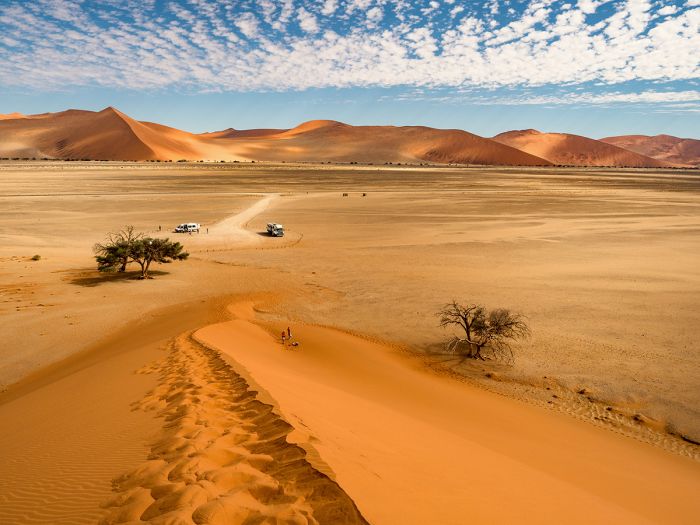
View from hike up Dune 45 in Sossusvlei.
Year-round Destination
The Sossusvlei and Namib-Naukluft region are characterized by a hot and arid desert climate, with little to no rainfall for much of the year. Daytime temps often spike above 100°F during the summer months (November through April), while nighttime temps can fall below freezing during the winter (May thru October).
The region can be considered a year-round destination, but count on warm to hot days, with temps rising fast once the sun rises, but cool to cold nights.
Thick fog that blows in from the Atlantic Ocean appears on some days in the early morning but burns off quickly.
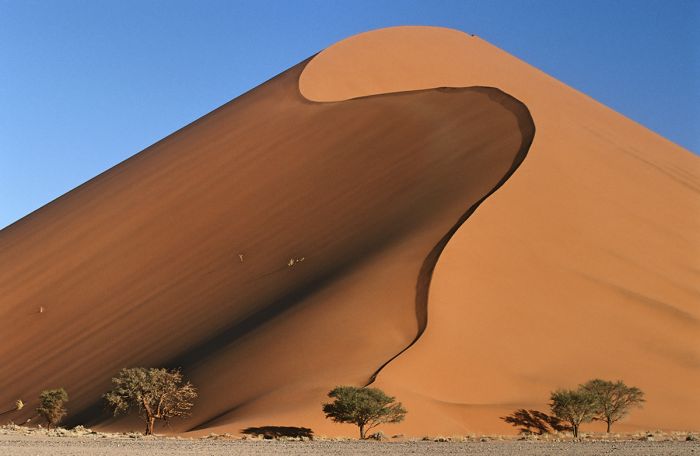
The spectacular Dune 45 in Sossusvlei, Namibia.
Summer
The summer months are November thru April and during this time, the desert is best described as hot. The temperatures during the day are always warm, averaging 82-85°F (28-29°C), but often reaching 100°F (38°C) or higher. Early mornings are very pleasant, with temps around 60°F (15°C), but the air warms up quickly once the sun comes up. The days are usually clear and sunny, with only spotty clouds blowing through.
Rains, although rare at any time, always occur in the summer. January and February have the most chance for rain, but again, it is very rare and typically only a brief shower if it does happen. Consider yourself lucky if you happen to be in the desert when it rains - everything comes to life at once!
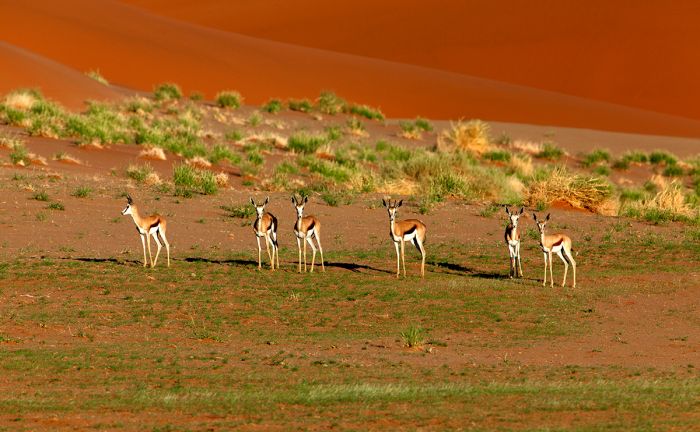
Springboks in front of a red sand dune in Sossusvlei with some fresh grass.
Winter
The winter months are May thru October and although the days are still quite warm, the nights can get quite cold (typical of a desert climate). Daytime temps average 73-75°F (23-24°C), but can often reach 80°F (27°C). Early mornings are chilly, averaging 48-50°F (9-10°C). Nighttime temps can drop to freezing or even lower.
Winter rains are essentially nonexistent and the air is extremely dry. Days are almost always sunny and cloud-free.
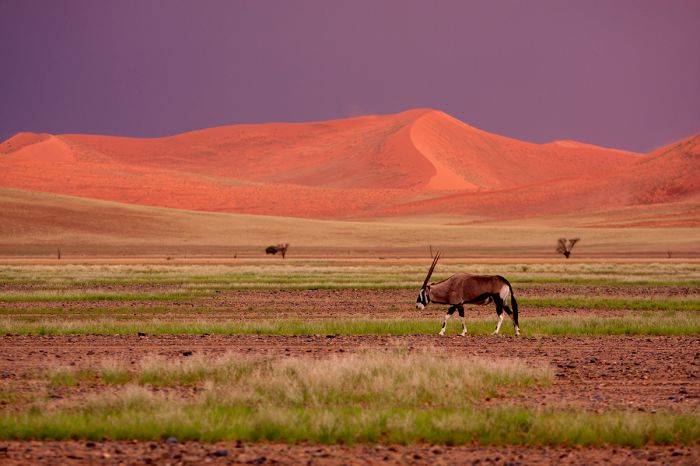
An oryx crosses the plain in the Namib-Naukluft National Park.
Showing 1–3 of 3 results
Situated in a private reserve with an exclusive-access entry to the Namib-Naukluft National Park and its spectacular desert landscapes. Nature drives, dune climbing, cycling, hot-air ballooning, and a great value.…
Situated in a private reserve with an exclusive-access entry to the Namib-Naukluft National Park and its spectacular desert landscapes. Nature drives, dune climbing, quad-biking, cycling, hot-air ballooning, and more.…




